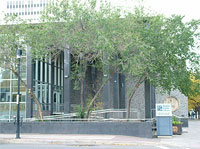
Sheboygan is a city in and the county seat of Sheboygan County, Wisconsin, United States. The population was 49,929 at the 2020 census. It is the principal city of the Sheboygan, Wisconsin Metropolitan Statistical Area, which has a population of 118,034. The city is located on the western shore of Lake Michigan at the mouth of the Sheboygan River, about 50 miles north of Milwaukee and 64 mi (103 km) south of Green Bay.

The Atlanta–Fulton Public Library System is a network of public libraries serving the City of Atlanta and Fulton County, both in the U.S. state of Georgia. The system is administered by Fulton County. The system is composed of the Atlanta Central Library in Downtown Atlanta, which serves as the library headquarters, as well as the Auburn Avenue Research Library on African American Culture and History, and 33 branch libraries.

The Huntsville-Madison County Public Library is a public, Carnegie library in Huntsville, Alabama. Founded in 1818, when Alabama was still a part of the Mississippi Territory, it is the oldest continuing library in the state.

The Federal Reserve Bank of Minneapolis, located in Minneapolis, Minnesota, in the United States, covers the 9th District of the Federal Reserve, which is made up of Minnesota, Montana, North and South Dakota, northwestern Wisconsin, and the Upper Peninsula of Michigan. Although its geographical territory is the third largest of the 12 Federal Reserve banks, it serves the smallest population base of the system. It has one branch, which is in Helena, Montana.

The New Orleans Public Library (NOPL) is the public library service of the city of New Orleans, Louisiana, United States.

Port Plaza Mall was an urban area shopping mall/multi-use facility located in downtown Green Bay, Wisconsin. The mall opened on August 10, 1977, and featured 3 anchor stores over the years, with JCPenney and H.C. Prange open at its launch and Boston Store added by 1982. The mall would go into a state of decline in the late 1990s and 2000s, Boston Store closed in 2000, Younkers which replaced Prange, closed in 2004, and JCPenney closed in 2005. The mall would close on February 27, 2006. The mall property was razed during the 1st half of 2012 as part of a redevelopment project; the headquarters of Schreiber Foods now stands on the main mall footprint.

The Jacksonville Public Library is the public library system of Jacksonville, Florida. It primarily serves Jacksonville and Duval County merged areas, and is also used by the neighboring Baker, Nassau, Clay, and St. Johns Counties. It is one of the largest library systems in Florida, with a collection of over three million items. A division of the city government, the library has the third largest group of city employees after the city's Fire Department and Sheriff's Office. There are twenty branches and a Main Library in the system.

The Akron-Summit County Public Library was founded in 1874, and operates Main Library on South High Street and South Main Street in downtown Akron, 18 branch libraries throughout the city of Akron and Summit County, the Akron Art Library, Project LEARN of Summit County Training Room, Mobile Services, and Project LEARN of Summit County. As of 2013, they have a lion cub mascot, named Paws.

The Regina Public Library is the citywide public library system of Regina, Saskatchewan, Canada.

The Hillsboro Public Library is a two-location public library system in Hillsboro, Oregon, United States. First opened in 1914 in a Carnegie library building, the system provides services to a population area of 137,000 people. As of 2015, the system had a usage of 922,000 visits per year, with circulation nearly 3 million items per year. One library is located near downtown in Shute Park, with the other location in the central portion of the city near the airport. The Hillsboro Public Library is part of Washington County Cooperative Library Services (WCCLS), which ensures library service is available to all residents of Washington County. As of 2015, the director of the library is Stephanie Chase.

The Niagara Falls Public Library, located at 1425 Main Street, in Niagara Falls in Niagara County, New York. The Main Library is the largest library in the Niagara-Orleans-Genesee Library System. The Main Library in the Earl W. Brydges Building, was built in 1974 by Paul Rudolph, and the LaSalle Branch is located at 8728 Buffalo Avenue in the LaSalle District of Niagara Falls.

The Harry Belafonte 115th Street Branch of the New York Public Library is a historic library building located in Harlem, New York City. It was designed by McKim, Mead & White and built in 1907–1908 and opened on November 6, 1908. It is a three-story-high, three-bay-wide building faced in deeply rusticated gray limestone in a Neo Italian Renaissance style. The branch was one of 65 built by the New York Public Library with funds provided by the philanthropist Andrew Carnegie, 11 of them designed by McKim, Mead & White. The building is 50 feet wide and features three evenly spaced arched openings on the first floor. The branch served as Harlem cultural center and hub of organizing efforts.

The Hamilton Grange Branch of the New York Public Library is a historic library building located in Hamilton Heights, Manhattan, New York City. It was designed by McKim, Mead & White and built in 1905–1906. The branch was one of 65 built by the New York Public Library with funds provided by the philanthropist Andrew Carnegie, 11 of them designed by McKim, Mead & White. It is a three-story-high, five-bay-wide building faced in deeply rusticated gray limestone in an Italian Renaissance style. The building features round arched openings on the first floor and bronze lamps and grilles.

The Santa Monica Public Library (SMPL) is the public library serving residents of Santa Monica, California and surrounding areas. SMPL is directed by a City Librarian, who reports to the Santa Monica City Manager's Office and is overseen by a Library Board consisting of five members appointed by the Santa Monica City Council.

The Kenton Library is a branch of the Multnomah County Library (MCL), in the Kenton neighborhood of Portland in the U.S. state of Oregon. Preceded by reading rooms in North Portland and later by the Lombard Branch Library, the Kenton Library opened in 2010 in a storefront on North Denver Avenue. The branch offers the MCL catalog of two million books, periodicals and other materials.

Memorial Mall is a former indoor shopping mall located in Sheboygan, Wisconsin, since redeveloped and anchored by a new Meijer hypermarket. Opened in 1969, it currently features Kohl's and four other smaller stores in the former south mall wing, with three additional stores within the Meijer space.

Plaza 8 was a pedestrian mall located in Downtown Sheboygan, Wisconsin. The mall stretched three and half city blocks in length from Ontario Avenue south past New York Avenue on North 8th Street. The area is now the Harbor Centre Downtown.

Madison Public Library (MPL), originally called the Madison Free Library, is the public library system in Madison, Wisconsin, United States, consisting of a central library and 8 neighborhood libraries. Madison Public Library is part of the South Central Library System, the second-largest public library system in Wisconsin after Milwaukee Public Library.





















